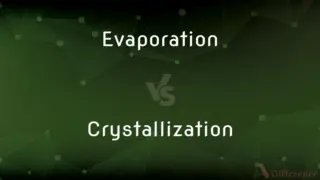Reduction Potential vs. Reducing Power — What's the Difference?
By Tayyaba Rehman — Published on November 26, 2023
Reduction Potential measures a substance's tendency to gain electrons. Reducing Power indicates a substance's ability to donate electrons. The former is quantitative, the latter qualitative.

Difference Between Reduction Potential and Reducing Power
Table of Contents
ADVERTISEMENT
Key Differences
Reduction Potential and Reducing Power, both relate to the redox reactions in chemistry. The Reduction Potential, often represented by the symbol E°, measures the tendency of a substance to accept electrons and get reduced. It is quantitatively measured in volts (V) and can be either positive or negative. A more positive reduction potential indicates a greater tendency to gain electrons.
Reducing Power, conversely, is more of a qualitative term that describes how well a substance can donate electrons to another substance, thereby reducing it. Substances with high reducing power are strong reducing agents and readily give up their electrons during chemical reactions. While Reduction Potential offers a numerical value on the electrode scale, Reducing Power does not provide a specific numeric value but instead gives a general indication of a substance's electron-donating ability.
Both Reduction Potential and Reducing Power play significant roles in various chemical and biological processes. For instance, in electrochemistry, the Reduction Potential of half-cells determines the direction of electron flow in an electrochemical cell. On the other hand, Reducing Power is a critical concept in biochemistry, especially when discussing cellular redox reactions, where certain molecules donate electrons to others.
While these terms are interconnected, it's vital to differentiate between them. Reduction Potential offers a precise, quantitative understanding of a substance's ability to get reduced. Reducing Power, however, paints a broader picture of a molecule's capability to act as a reducing agent without quantifying this ability.
Comparison Chart
Nature
Quantitative
Qualitative
ADVERTISEMENT
Definition
Tendency to gain electrons
Ability to donate electrons
Measurement
Measured in volts (V)
Not specifically measured
Application Field
Electrochemistry
Biochemistry, General Chemistry
Example
E° of Cu^2+/Cu is positive
Antioxidants have high reducing power
Compare with Definitions
Reduction Potential
Voltage at which reduction occurs at an electrode.
The higher the reduction potential, the more likely the reduction.
Reducing Power
Measure of how effectively a substance can reduce others.
A strong reducing agent exhibits high reducing power.
Reduction Potential
Quantitative measure of how easily a species is reduced.
A positive reduction potential indicates a substance can be easily reduced.
Reducing Power
Indicator of strength as a reducing agent.
Lithium, due to its high reducing power, is used in batteries.
Reduction Potential
Tendency of a substance to gain electrons.
The reduction potential of hydrogen is set as zero volts.
Reducing Power
Ability of a substance to donate electrons.
Metal hydrides generally possess a high reducing power.
Reduction Potential
Relative potential of a half-cell vs. a standard.
The standard reduction potential of an electrode is measured against a standard hydrogen electrode.
Reducing Power
Not quantitatively measured like reduction potential.
Though its reducing power is known, it's not given in volts.
Reduction Potential
Indicator of substance's reactivity in redox reactions.
Gold, with a high reduction potential, is less reactive than zinc.
Reducing Power
Qualitative assessment of electron-donating capability.
In biochemistry, NADH is known for its reducing power.
Common Curiosities
What does reduction potential measure?
Reduction Potential measures a substance's tendency to gain electrons.
Is a positive reduction potential good?
A positive reduction potential indicates a strong tendency to gain electrons.
Can a substance with a negative reduction potential have high reducing power?
Yes, a negative reduction potential often indicates a substance has high reducing power as it prefers to donate electrons.
What substances have high reducing power?
Strong reducing agents, like certain metals, have high reducing power.
Which is more specific, reduction potential or reducing power?
Reduction potential is more specific as it provides a quantitative value, while reducing power is more general.
How is reducing power different from reduction potential?
Reducing Power is a qualitative measure of electron-donating ability, while reduction potential is quantitative.
Can the same substance have both a reduction potential and reducing power?
Yes, a substance's reduction potential indicates its tendency to gain electrons, while its reducing power indicates its ability to donate them.
What role does reducing power play in biology?
Reducing power is essential in many biological processes, especially in redox reactions within cells.
How are these terms relevant in redox reactions?
In redox reactions, the substance with a higher reduction potential is reduced, while the one with higher reducing power acts as a reducing agent.
How is reduction potential used in batteries?
The difference in reduction potential between two metals is used to generate a voltage in batteries.
Why don't we have a specific unit for reducing power?
Reducing power is qualitative, describing a general ability rather than a specific, measurable tendency like reduction potential.
What can influence a substance's reduction potential?
Concentration, temperature, and presence of other substances can influence reduction potential.
Why is reduction potential often measured against hydrogen?
Hydrogen is used as a reference with its potential set at zero, allowing for relative measurements.
Is reducing power related to oxidizing power?
Yes, a substance with high reducing power typically has low oxidizing power and vice versa.
Do all substances have a reduction potential?
Not all substances have a defined reduction potential, but many involved in redox reactions do.
Share Your Discovery

Previous Comparison
Evaporation vs. Crystallization
Next Comparison
Mother’s Day vs. Father’s DayAuthor Spotlight
Written by
Tayyaba RehmanTayyaba Rehman is a distinguished writer, currently serving as a primary contributor to askdifference.com. As a researcher in semantics and etymology, Tayyaba's passion for the complexity of languages and their distinctions has found a perfect home on the platform. Tayyaba delves into the intricacies of language, distinguishing between commonly confused words and phrases, thereby providing clarity for readers worldwide.












































